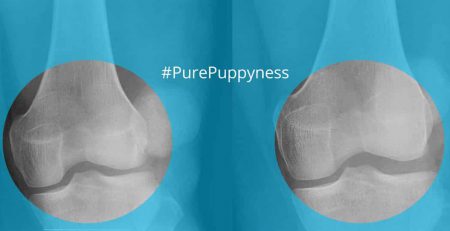Dog Food Allergies
Imagine the situation: your dog is itching like crazy. They’ve lost huge chunks of fur, and their skin is looking raw. Maybe they have an ear infection, or puffy eyelids. You’ve treated your pet for fleas and ticks, but the itching continues, and you’re at your wit’s end. Don’t lose hope! It could be that your dog has a food allergy.
What is a food allergy?
A true food allergy (also called a food hypersensitivity) leads to an immune response when the animal eats a particular food item. The consequences can be severe or even deadly to the animal.
What is food intolerance?
An animal can eat small amounts of a particular food, but in quantities, the animal will suffer from digestive issues. The symptoms triggered by food intolerance are far less severe, and are usually limited to the Gastro-Intestinal System.
What happens when a dog has a food allergy?
When an animal’s immune system accidentally identifies a food protein as a harmful invader, it will start an immune response. This typically results in dermatitis, which eventually leads to itching, which in turn can lead to skin or ear infections. Gastrointestinal symptoms, such as vomiting and diarrhoea, may also occur.
Which dogs are affected by food allergies?
The exact prevalence of food allergies in dogs is currently unknown. Some breeds are more commonly affected, such as Labrador Retrievers, West Highland White Terriers, and Cocker Spaniels. Food hypersensitivity with Protein Losing Enteropathy (a condition in which the digestive tract loses proteins) and Nephropathy (a disease in which the kidneys lose proteins to the urine) can occur in Soft Coated Wheaten Terriers.
The age of onset varies considerably, ranging from two months old to 14 years old. Most food allergies seem to begin when the dog is under 12 months old. In the case of adult dogs that develop food hypersensitivity, they will typically have been eating the allergen in questions for more than two years.
What are the symptoms of a food allergy?
Food allergies cause non-seasonal skin and/or gastrointestinal disorders. Severe itching (Pruritus) is the main issue and is mostly corticoid-resistant. Ear canal disease that manifests as pruritus and secondary bacterial or yeast infection are also common, because itching can create open wounds for bacteria and other harmful organisms to invade. Swollen eyelids are also common.
Dogs tend to itch and lose hair on the ears, feet, between the hind legs, under the front legs, on the front of the forelegs, around the eyes, and on the muzzle.
What foods can cause an allergic reaction?
The most common “allergenic” foods for dogs are:
- Beef
- Chicken
- Eggs
- Corn
- Wheat
- Soy
- Milk
How are dog food allergies diagnosed?
Unfortunately, there is no reliable diagnostic test other than a strict food elimination diet. Many tests using blood, saliva, and even hair can be performed a veterinarian or purchased by a pet owner online but there is no proof that they work.
An elimination diet involves feeding your dog a special hypoallergenic diet that contains no allergens. The ideal food elimination diet should be:
- Balanced
- Nutritionally complete
- Not containing any ingredients that have previously been fed
Elimination diets should contain novel protein or carbohydrate sources (such as venison and rice). A novel protein or carbohydrate is one that a dog has not encountered before, so they are far less likely to have an allergic reaction to it. If the elimination diet contains a previously fed ingredient, which the animal is allergic to, then the diet trial will be a failure. This means that you cannot feed anything, including treats, scraps or flavoured chews, to your dog, except for the special hypoallergenic diet. Similar to the recipe by Petzyo, the hypoallergenic diet should ideally have limited ingredients, so you will know exactly what your pet is eating.
To confirm that a food allergy exists, the animal should eat previously fed food ingredients. If the clinical signs reoccur, the food allergy is confirmed. Clinical signs usually return between one hour and 14 days later. Once a food allergy is confirmed, the elimination diet should be started until clinical signs resolved: this usually takes 14 days or less. One ingredient at a time should be tested to see if it causes allergic symptoms in the pet. This test will prove that the special diet helps the pet and that it isn’t a coincidental improvement.
What’s the treatment for dog food allergies?
Food allergy typically does not respond well to corticosteroids or other medical treatments. Feeding a specialised diet will help to manage the pet’s symptoms. Your dog can be fed a special home-made diet, or a pre-made specially formulated hypoallergenic diet: your vet will help you to decide what the best option for your dog is. Sadly there is no cure for food allergies, but they can be managed with a bit of care and patience.






















